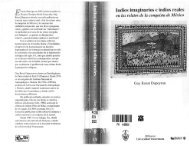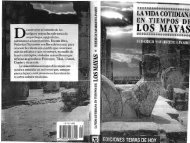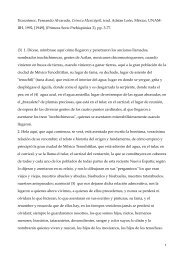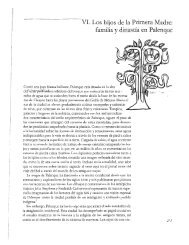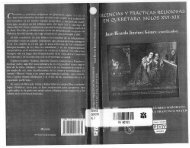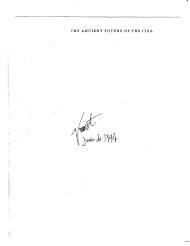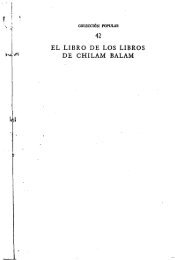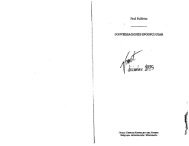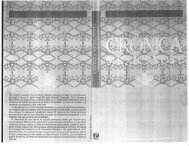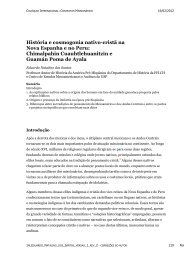HEAVEN BORN MERIDA AND ITS DESTINY - Histomesoamericana
HEAVEN BORN MERIDA AND ITS DESTINY - Histomesoamericana
HEAVEN BORN MERIDA AND ITS DESTINY - Histomesoamericana
Create successful ePaper yourself
Turn your PDF publications into a flip-book with our unique Google optimized e-Paper software.
INTRODUCTION<br />
and Barrera (1948: 65) interpret these expressions as referring to diseases,<br />
but from the contexts in which they occur I am convinced that they allude<br />
to the calendar round and its sacrifices (see below).<br />
As gods, but again also as priests, the yearbearers are identified as Fathers<br />
of the Land [ba cabob) and as rain gods [chacob], and they may also<br />
be identical with the four Stone Giants [pauah tun), the four winds [ikil),<br />
and the four death gods [tenel ahau). They are also closely associated<br />
with the four Burners [ah toe). All these sets of deities, then, are in charge<br />
of time, rain, death, the sky, and fire, and they are conceived in various<br />
connections as bearing the burden of the sun and holding up the four corners<br />
of the sky.<br />
Because of their directional associations, the yearbearer priests also appear<br />
to be given color titles: red, white, black, and yellow for east, north,<br />
west, and south, respectively. They may all be referred to by the suffixed<br />
title chac 'rain priest', but the prefixed title chac 'red' refers to the East<br />
priest. | Chac may also mean 'boil, fuzz, appear, trample, big' and is the<br />
name of a lineage and a village as well, so it is not always easy to determine<br />
which meaning is intended.) In some contexts a fifth priest is added<br />
to the basic four, identified with the color yax 'blue/green' and the direction<br />
of the center. Unlike Roys (1967: 139, notes), I regard this usage as a<br />
Mexican aberration.<br />
The rain priests, who apparently wore ceremonial necklaces, are referred<br />
to as necklaced rain priests [yuuan chac). They were also identified<br />
by honorific kinship terms (father, mother's mother, and younger brother<br />
rain priest). The yearbearer ceremonies of 11 Ahau are described in detail<br />
in chapter 15.<br />
4. Kin tun y abil 'day stone year period' and ma ya cimlal 'no pain<br />
death, Maya death'. These two expressions have commonly been interpreted<br />
on the basis of colonial dictionaries as 'drought' and 'pestilence',<br />
respectively. I believe that this interpretation is usually (though perhaps<br />
not always) wrong as a reading oí the Chumayel text. The phrases occur<br />
as a couplet in lines 5039-5040 (and in the Tizimin, lines 319-320,<br />
2615-2616). Kin tun y abil occurs alone in lines 1247, 5158, 5224, and<br />
6178; and ma y a cimlal occurs in lines 112, 338, 2643, 4922, 5325, and<br />
6283 (also in the Tizimin, lines 675, 722, 2770, 2920, 3646, 3932, 4090,<br />
4537, 4637, 4771, and 5269). I read them as 'calendar round' and 'no pain<br />
death', respectively, and I consider the latter expression as a euphemism<br />
for sacrifice, perhaps specifically for calendar round sacrifices.<br />
If the calendar round in the Mayapan calendar (see below) began on 1<br />
Kan, as I believe it did, there are eight such beginnings in the twenty<br />
katuns between 1441 and 1848. If the calendar round began on 1 Ik, as I<br />
believe it did in the Tikal calendar (see below), there are eight such beginnings<br />
in the same time span, but they land in different katuns. Four katuns<br />
oí the twenty do not correspond to the beginning of a calendar round<br />
in either system.<br />
Six of the eight calendar round beginnings in the Tikal calendar correspond<br />
to katuns in which either kin tun y abil or ma ya cimlal or both<br />
are mentioned in the Chumayel or the Tizimin. The calendar rounds be-



